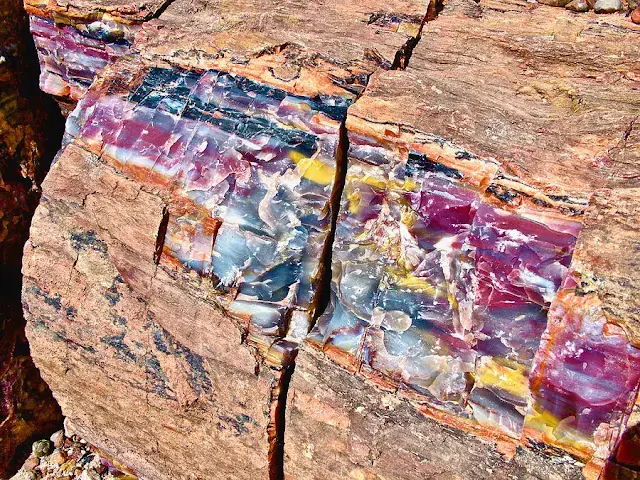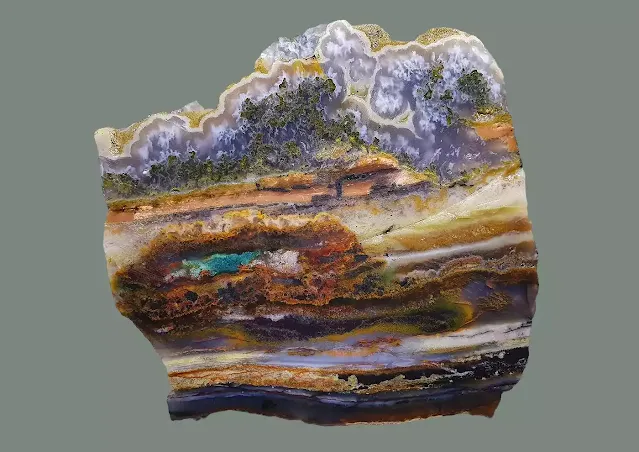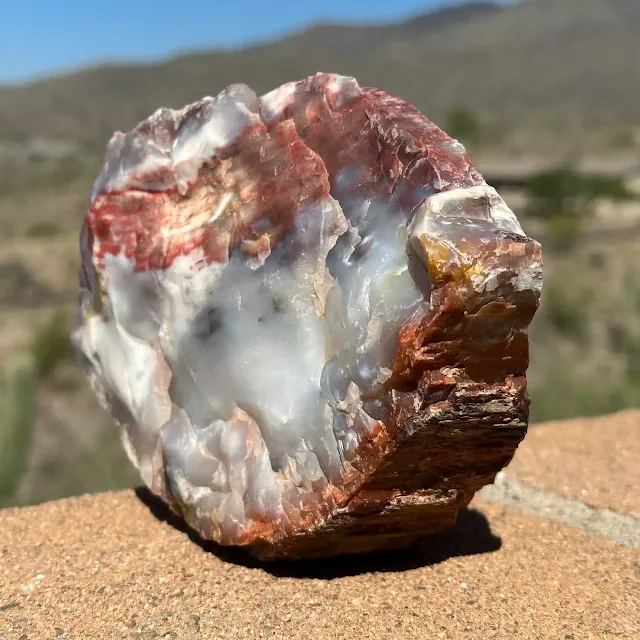Agatized Wood: Gemstone, Value, Uses
What is Agatized Wood
Agatized wood is a type of fossilized wood where the original organic material has been replaced by agate, a variety of chalcedony, which is a microcrystalline form of quartz. Agatized wood formed from the petrification of ancient wood. This process preserves the intricate details of the wood grain while transforming it into a vibrant and durable gemstone.
Agatized wood is a captivating example of nature's ability to
transform organic materials into enduring works of art through the slow
process of fossilization.
Agatized wood is a type of petrified wood.
 |
| Agatized Wood: Gemstone, Value, Uses |
How is Agatized Wood Formed?
Agatized wood forms over millions of years through a process called permineralization. It begins when trees or branches are buried under sediment or volcanic ash shortly after falling. Over time, groundwater rich in dissolved silica (often from volcanic ash) seeps into the buried wood, replacing the original organic material with silica minerals such as quartz or chalcedony.
This process preserves the wood's structure down to the cellular level, resulting in a fossilized specimen that retains the appearance and texture of wood while exhibiting the vibrant colors and patterns of agate.
Characteristics & Properties of Agatized Wood
Chemical Composition: Agatized wood is primarily composed of silica minerals, such as quartz or chalcedony, which replace the organic material of the original wood. Trace elements and mineral impurities contribute to the diverse range of colors observed in agatized wood specimens.
Color and Pattern: Agatized wood comes in a variety of colors, including browns, reds, yellows, oranges, and even blues and greens. The colors are often due to the presence of different minerals and impurities within the silica. The stone also retains the characteristic wood grain patterns, making it visually captivating.
Lustre: Agatized wood often displays a glassy or waxy lustre, adding to its visual appeal. This lustre is a result of the fine-grained nature of the silica minerals that replace the wood.
Transparency: Agatized wood can be translucent to opaque, depending on the amount of silica present.
Hardness: Due to the replacement of organic material with silica minerals, agatized wood becomes extremely hard and durable, often with a Mohs hardness of 6.5 to 7.
Grain Structure: Despite the transformation into stone, agatized wood often retains the visible grain structure of the original wood. Growth rings, knots, and other features characteristic of the tree's structure can still be observed, providing a tangible link to the fossilized plant's history.
Polishability: Agatized wood takes a high polish, making it ideal for use in jewelry and other decorative items.
Heat resistance: Agatized wood is heat resistant, making it safe for use in jewelry that comes into contact with skin.
Chemical resistance: Agatized wood is resistant to most chemicals, making it easy to clean and care for.
Read also: Types of Agate With Photos
 |
| Agatized Wood , from Petrified Forest National Park, Arizona. Photograph by Ruth Hager |
Where is Agatized Wood Found?
Agatized wood can be found in various locations worldwide, but some areas are particularly renowned for their abundance and quality:
United States:
- Oregon: Known for its colorful and well-preserved agatized wood, particularly in the John Day Fossil Beds National Monument.
- Wyoming: Famous for its "Wyoming jade," a beautiful green and blue agatized wood found in the Wind River Basin.
- Arizona: Home to the Petrified Forest National Park, where vast petrified logs showcase the diversity of agatized wood.
- California: Agatized wood can be found in various locations throughout the state, including the Sierra Nevada Mountains and the Coast Ranges.
Canada: British Columbia is known for its agatized wood with unique patterns and colors.
Brazil: The Rio Grande do Sul region is famous for its agate-filled geodes, often containing beautiful agatized wood inclusions.
Germany: The Rhine River valley is a source of agatized wood with a distinctive brown and white banding.
Madagascar: Home to a unique variety of agatized wood, including the vibrantly colored "dinosaur bone agate."
Morocco: Known for its "desert jasper," a type of agatized wood with a distinctive yellow and brown coloration.
Indonesia: The island of Java is a source of colorful and well-preserved agatized wood.
India: The Deccan Traps region yields agatized wood with a variety of colors and patterns.
 |
| Agatized petrified wood. Photo: Chille Maulidhaa |
Uses and Applications of Agatized Wood
Ornamental and Decorative
Jewelry: Agatized wood is most commonly used in jewelry making, cut into cabochons, beads, pendants, and other components. Its unique colors and patterns make stunning pieces.
Decorative objects: Polished agatized wood slabs can be used for tabletops, countertops, bowls, figurines, and sculptures, adding a touch of natural beauty to any space.
Furniture: Inlays and veneers made from agatized wood can add a unique and luxurious touch to furniture pieces.
Mosaics and art installations: Agatized wood pieces can be incorporated into mosaics and art installations, creating captivating and unique designs.
Scientific and Educational
Paleontology: Studying the preserved wood grain patterns and other features of agatized wood can help paleontologists understand the types of trees that existed millions of years ago and the environments they grew in.
Archaeology: Agatized wood artifacts can be used to date archaeological sites and provide clues about past cultures.
Museum exhibits: Agatized wood specimens are often displayed in museums, allowing visitors to appreciate their beauty and learn about their geological history.
Other Uses
Metaphysical beliefs: Some people use agatized wood for its perceived metaphysical properties, believing it promotes grounding, stability, and growth.
Healing crystals: In alternative healing practices, agatized wood is sometimes used as a healing crystal, although there is no scientific evidence to support these claims.
Collecting: Agatized wood can be a valuable collectible for mineral enthusiasts and those who appreciate natural beauty.
 |
| Agatized Wood -Arizona |
Agatized Wood Value
The value of agatized wood can vary greatly depending on several factors:
Quality:
Color and Pattern: More vibrant colors, banding patterns, and unique characteristics increase value.
Clarity and Transparency: Higher transparency and fewer blemishes make it more valuable.
Polish and Finish: A high-quality polish and finish enhances the beauty and value.
Size and Shape: Larger pieces, especially unique shapes, can be more valuable.
Rarity and Origin: Certain locations or types of agatized wood with limited availability are more valuable.
Here's a general range to give you an idea:
- Small, unpolished pieces: $10-$50
- Polished cabochons or beads: $20-$100+
- Larger polished slabs or carvings: $100-$1,000+
- Museum-quality specimens: Thousands or even tens of thousands of dollars
- Large, high-quality carvings or sculptures: Thousands to tens of thousands of dollars
Wood Replacements Comparison
Agatized Wood Vs Opalized Wood
While both agatized wood and opalized wood result from the fossilization of wood by silica minerals, they differ in the specific minerals involved and the visual characteristics they exhibit. Agatized wood displays vibrant colors and banded patterns reminiscent of agate, whereas opalized wood showcases the mesmerizing play-of-color typical of opal.
Agatized Wood Vs Petrified Wood
Petrified wood is a broad term encompassing all types of fossilized wood where the original organic material has been replaced by minerals, typically silica (often quartz or chalcedony). Agatized wood specifically refers to wood that has undergone the petrification process with a significant replacement by agate-forming minerals, such as chalcedony or quartz. In summary, all agatized wood can be considered petrified wood, but not all petrified wood is necessarily agatized. The distinction lies in the specific minerals that replace the original organic material. If the replacement minerals are primarily agate-forming, the term "agatized wood" is more accurate. Both terms, however, are commonly used interchangeably in the context of fossilized wood.
Conclusion
In conclusion, agatized wood, through a meticulous process of permineralization, emerges as a testament to Earth's geological evolution. Its physical properties, geological significance, and versatile applications underscore its importance in both scientific research and aesthetic pursuits. Whether admired for its scientific value, incorporated into artistic creations, or simply cherished for its natural beauty, agatized wood continues to intrigue and inspire those who explore the wonders of our planet's geological history.
Read also: Turritella Agate: Fossilized Snail Gemstone
Agatized Dinosaur Bone

%20(1).webp)






